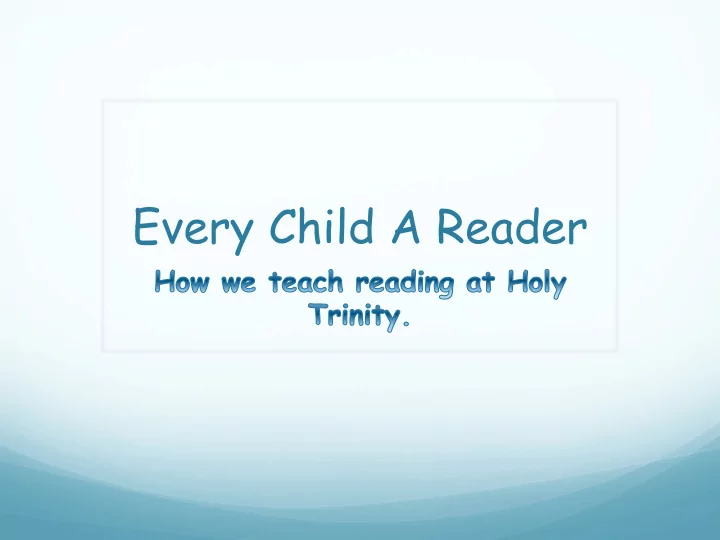

Every Child A Reader
What is Literacy? The ability to speak, listen, read and write. The ability to locate, evaluate, use and communicate meaning using a wide range of resources.
Essential Elements of Literacy 1. Phonemic Awareness 2. Phonics 3. Fluency 4. Vocabulary 5. Comprehension
Phonological Awareness - The understanding that spoken language is made up of individual and separate sounds. How many sounds are there in the English language? Phonological awareness activities can involve work with rhymes, words, sentences, syllables, and phonemes . This is the main focus of our work in Reception. We use the ‘Letters and Sounds’ scheme to provide high quality provision and systematic teaching of synthetic phonics.
Letters and Sounds. Phase 1 – This phase has 7 aspects all of which develop sound discrimination, patterns and rhythm in words and oral segmenting and blending. Phase 2 – This phase teaches 19 sounds and moves from oral understanding to blending of letters. Phase 3 – 25 more sounds, including sounds made with 2 letters eg sh Phase 4 – Children will know 44 phonemes and be able to correctly represent any word in its written form phonologically. Phase 5 & 6 – this will be covered in KS1.
Terminology the children will use. Phonics - the special lesson that will take place every morning. Be in school every day on time or ‘phonics’ will be missed. Phoneme – single unit of sound. This could be a single letter sound ‘g’, a digraph or 2 letter sound unit ‘sh’, a trigraph ‘igh’. Blending and segmenting. Segmenting (robot talk) is when words are split into their sound components m- a-t, blending is when individual phonemes are sounded to make a word making it ‘fluent’.
Resources we use Jolly phonic actions and songs to introduce the letters Sound mats or basic codes Sound button cards Letter fans, white boards, magnetic letters. CVC pictures to introduce writing Letters and sounds activities on the class whiteboard
Can all words be decoded? Not all words can be decoded using our phonic skills. We call these our ‘Tricky Words’. The children may refer to them as our ‘rocket words’ as they are displayed in the classrooms on individual rockets. Phase 2 - no, go, the, I, to Phase 3 – he, she, we, me, be, was, my, you, they, her, all, are. As the children become secure with these and they develop as readers we introduce High Frequency Words eg some, Mr, them
How you can help. Every Friday the sounds introduced that week will be sent home to practice. Please keep these sheets at home and practice the sounds and action every day. Reading books will be chosen by the children and can be changed on a Monday, Wednesday and Friday. Please return to the reading book box in each class. A reading diary will accompany the reading book. This is your record of books you have read together at home. We check and initial your comments and will write in the book regularly. Detailed reading records are kept by class teachers. Please ask for a progress report.
TALK with your child during everyday activities and include your child in a variety of activities . Look through a book before reading a story and ask your child to use words to describe the pictures. Make refrigerator magnet words F Read with your child everyday, smoothly pointing to words as you read. Read a story, poem or play to your child, with expression . Then ask him to read the same page out loud to/with you. Ask your child to read familiar stories over and over. See if she can read the story more quickly and smoothly over time. Check out books from the library with your child. Read the book ’ s title, or look at the pictures, and ask what he or she thinks the book is about. Ask your child to retell parts of a story to you after reading together. Allow your child to read and carry out favorite recipes
Recommend
More recommend